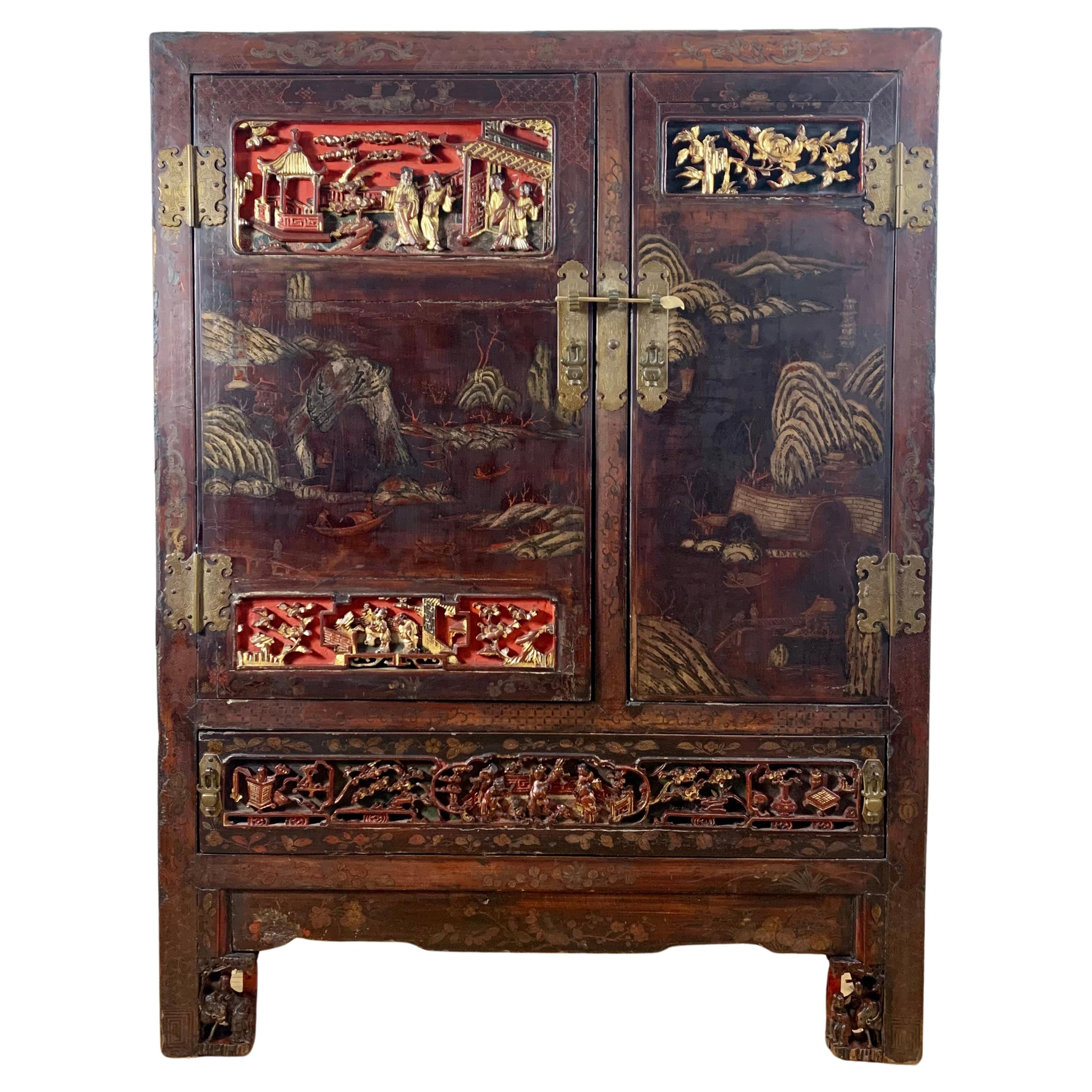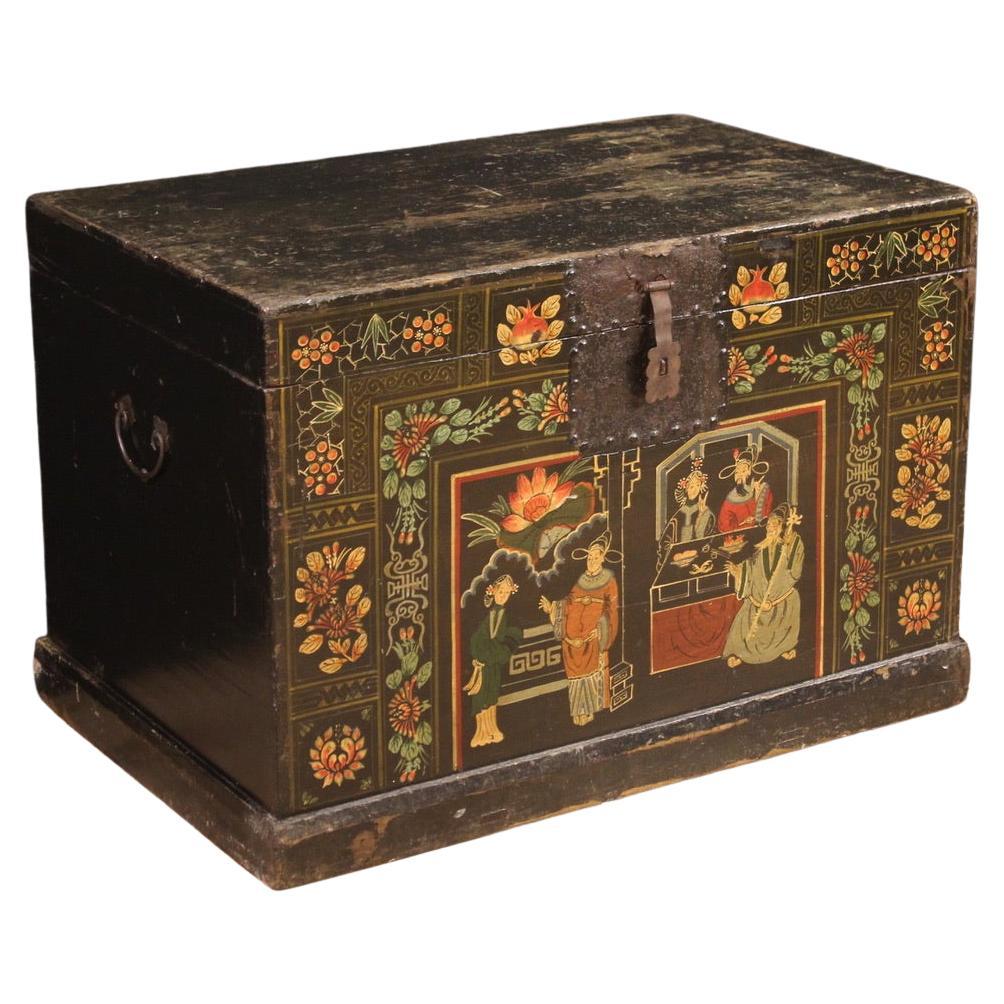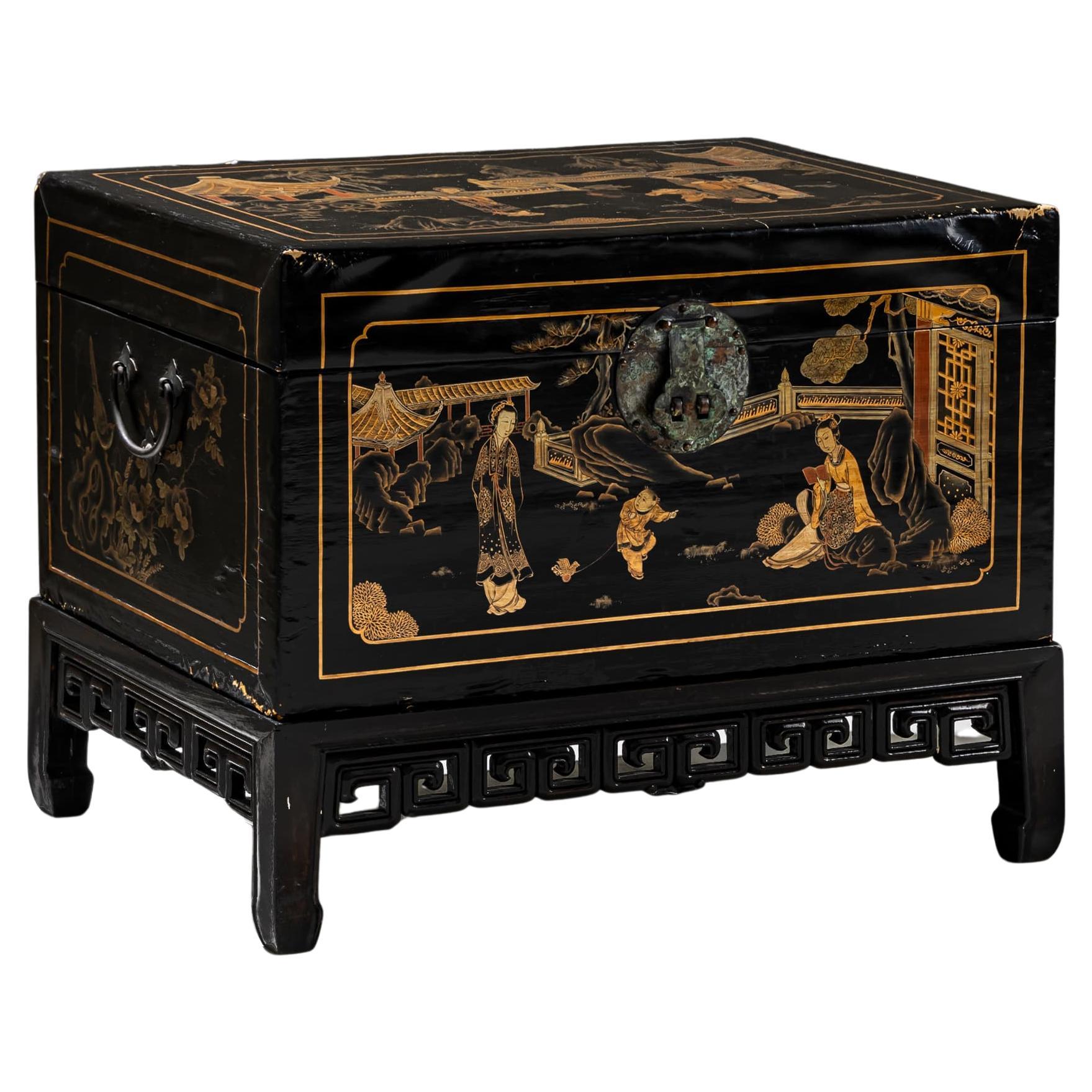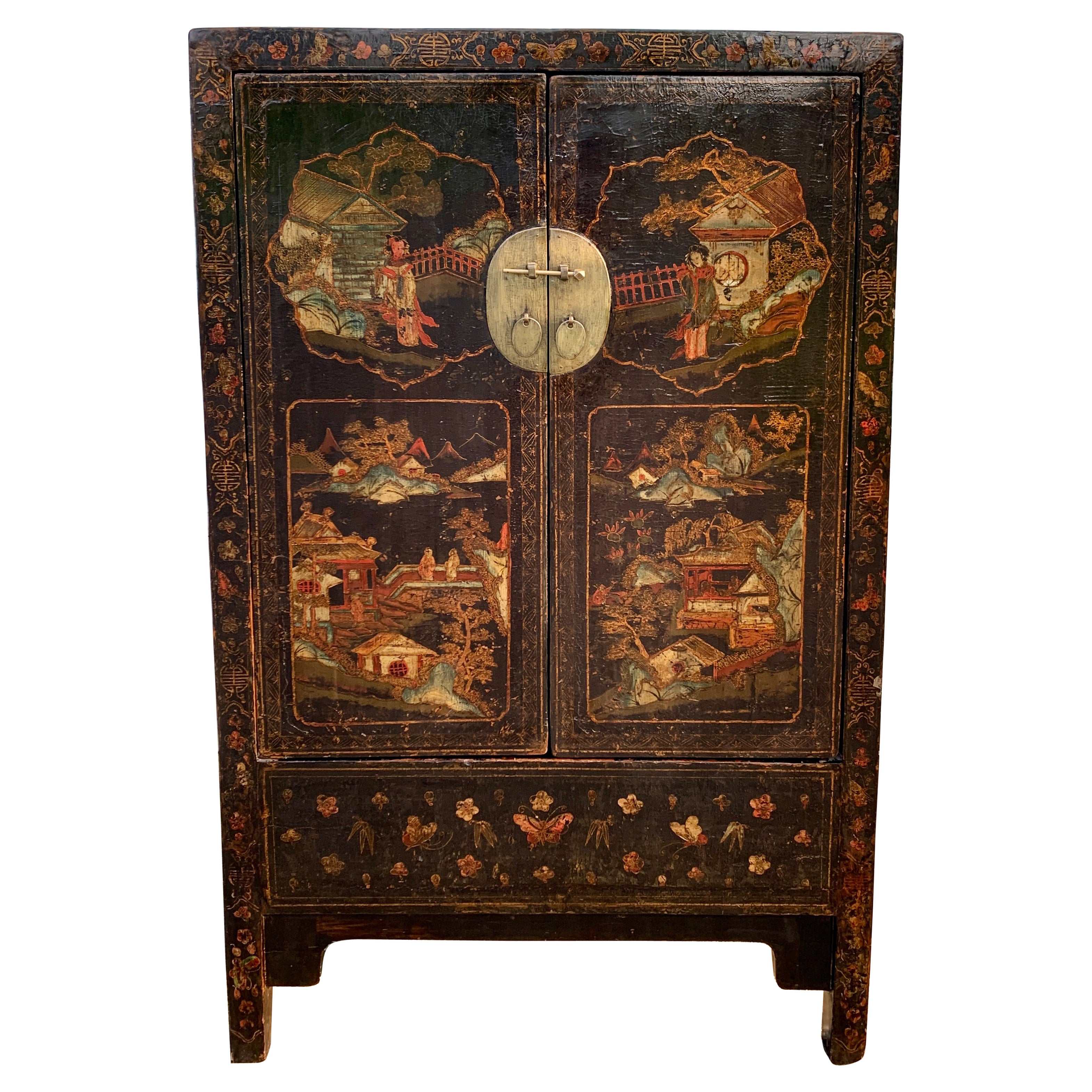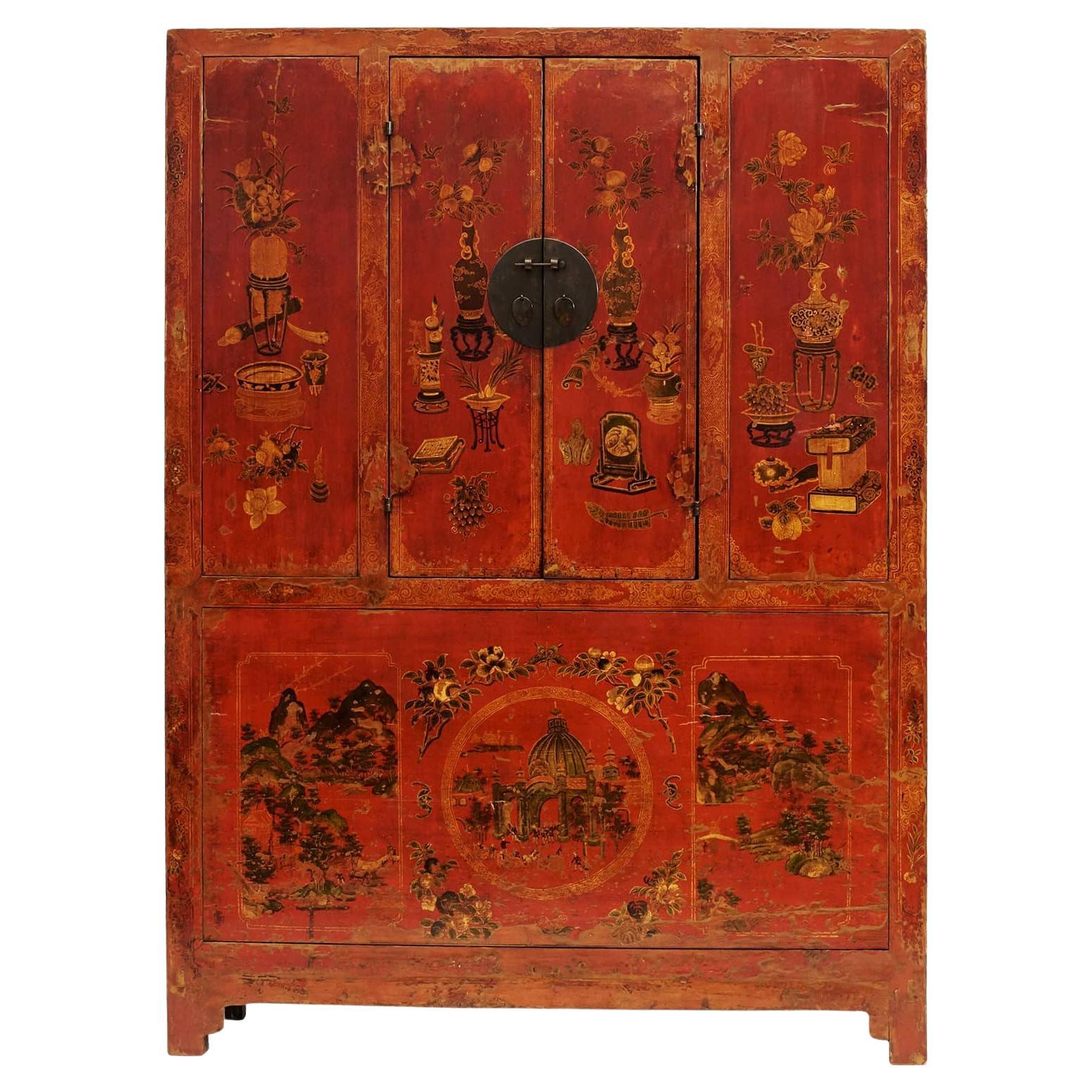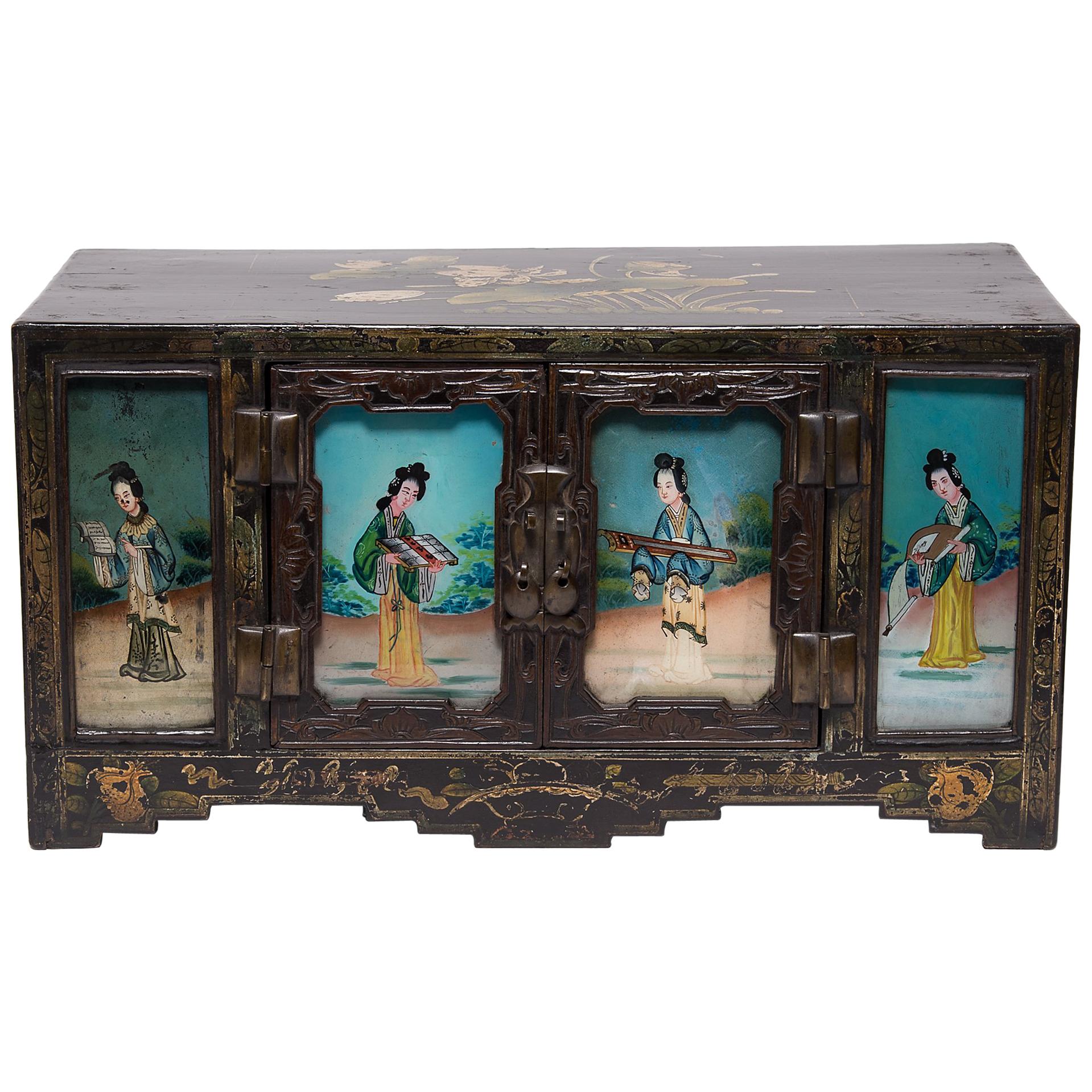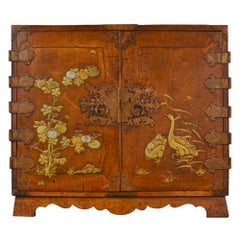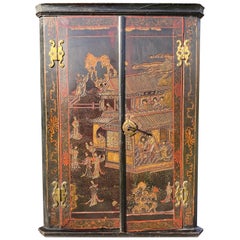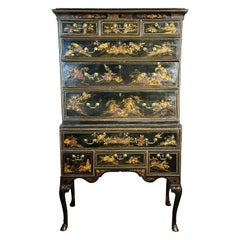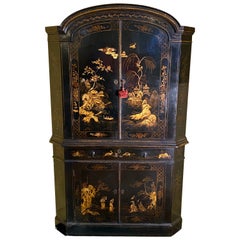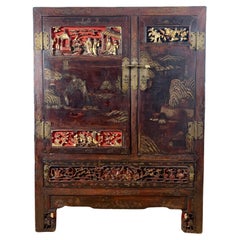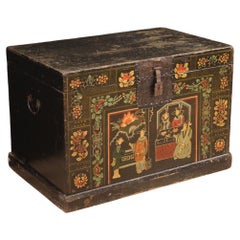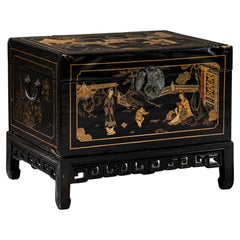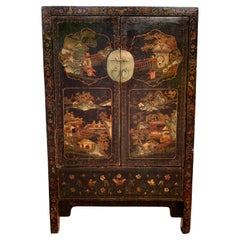Items Similar to Rare Chinese Kangxi Polychrome Coromandel Lacquer Casket
Video Loading
Want more images or videos?
Request additional images or videos from the seller
1 of 13
Rare Chinese Kangxi Polychrome Coromandel Lacquer Casket
$16,656.75
£11,880
€14,115.34
CA$22,731.68
A$25,313.77
CHF 13,174.42
MX$312,115.79
NOK 167,786.32
SEK 157,702.88
DKK 105,317.98
Shipping
Retrieving quote...The 1stDibs Promise:
Authenticity Guarantee,
Money-Back Guarantee,
24-Hour Cancellation
About the Item
A rare Chinese polychrome Coromandel or ‘Bantam Ware’ lacquer casket or table cabinet, Kangxi period (1661-1722). Circa 1700.
This fine small Chinese-export lacquer fitted casket is decorated overall with polychrome incised decoration. Opening with two doors revealing a red interior with fitted drawers and a hinged rising top. In superb, almost entirely original condition, retaining its vivid colours and fine details with courtiers in a pavilion and on horseback amidst foliage and formal palace gardens. The small bun-type feet are historical replacements. Interestingly bearing an antique-script inventory #25 and A I on the base.
Nb. Bantamwork or Coromandel lacquer, not to be confused with ‘japanning’, is the term applied to decoration that is cut into a layer of gesso and then lacquered in colours. Much of the lacquer was transhipped from China through Coromandel in India, or the Dutch colony Batavia, Java.
References:
Coromandel lacquer or 'Bantamwork', with its characteristic incised decoration, was made in Henan province in Northern China from the latter-part of the Ming dynasty and exported to Europe from the end of the 17th Century through the East India Company's and VOC trading posts on the Coromandel Coast of India. The technique consisted in overlaying a base of wood with a series of increasingly fine white clays and fibrous grasses. Over this surface, lacquer was applied and polished before the design was incised and the hollowed out portions filled with colour and gilt and finished with a clear lacquer to protect it.
Although John Stalker and George Parker used the term 'Bantamwork', the contemporary layman usually called it 'cutt-work', 'cutt Japan' or 'hollow burnt Japan'. Stalker and Parker discuss two types of 'Bantam-work' - flat and incised - in their 'Treatise on Japanning and Varnishing' (1688), noting that it 'was done in colors mix't with a gum water'. They also considered that it was 'almost obsolete, and out of fashion, out of use and neglected....' although admitted that 'it was very pretty, and some are more fond of it, and prefer it to the other...'.
This casket/ table cabinet now on offer is related to one formerly with Malletts and illustrated in A. Bowett, 'English Furniture 1660-1714: From Charles II to Queen Anne' (2002) p. 150, plates 5:9.
A much larger yet closely-related Bantam work coffer with rising lid was offered in the 'Asian Art in Cologne' sale lot 114 on 11th December 2021. Estimated @ £ 60,000 - £79,000.
Mme de Pompadour, mistress to King Louis XV from 1745 to 1751, was an avid collector and admirer of Chinese Coromandel or Bantam Work, and was probably largely responsible for the very high prices recorded for such pieces, sometimes 10 times or more the price of ordinary furniture of equivalent quality.
A Coromandel cabinet on stand was sold at Christies London, from the Simon Sainsbury collection, on 18th June 2008 @ £ 30,000. Catalogued as William III, ca 1690.
Literature:
John Stalker and George Parker 'Treatise of Japanning and Varnishing' (1688).
Further reading:
Coromandel lacquer - Wikipedia.
A Technical Study on Chinese Lacquer Technology (2018).
Bantamwork - Wikipedia.
Coromandel – Coco Chanel’s obsession, Lampoon Magazine (2021).
V & A Museum, London, Articles - East Asian lacquer
The influence of East Asian lacquer on European furniture…
- Dimensions:Height: 15.56 in (39.5 cm)Width: 15.56 in (39.5 cm)Depth: 13.39 in (34 cm)
- Materials and Techniques:
- Place of Origin:
- Period:
- Date of Manufacture:circa 1700
- Condition:Replacements made: The small bun-type feet are historical replacements. Minor repairs predominantly to the leading edges, as one would expect on something of this age. Wear consistent with age and use. In superb, almost entirely original condition, retaining its vivid colours and very fine details.
- Seller Location:Lymington, GB
- Reference Number:Seller: BHA 12061stDibs: LU4081134391652
About the Seller
5.0
Vetted Professional Seller
Every seller passes strict standards for authenticity and reliability
Established in 1957
1stDibs seller since 2018
36 sales on 1stDibs
- ShippingRetrieving quote...Shipping from: Lymington, United Kingdom
- Return Policy
Authenticity Guarantee
In the unlikely event there’s an issue with an item’s authenticity, contact us within 1 year for a full refund. DetailsMoney-Back Guarantee
If your item is not as described, is damaged in transit, or does not arrive, contact us within 7 days for a full refund. Details24-Hour Cancellation
You have a 24-hour grace period in which to reconsider your purchase, with no questions asked.Vetted Professional Sellers
Our world-class sellers must adhere to strict standards for service and quality, maintaining the integrity of our listings.Price-Match Guarantee
If you find that a seller listed the same item for a lower price elsewhere, we’ll match it.Trusted Global Delivery
Our best-in-class carrier network provides specialized shipping options worldwide, including custom delivery.More From This Seller
View AllFine and Rare 17th Century Japanese Mulberry Wood Gilt-Lacquer Cabinet on Stand
Located in Lymington, GB
An outstanding and rare, 17th-century Japanese mulberrywood gilt-lacquer cabinet raised on a later stand.
This fine and exceptional two-door, gilt-heightened cabinet - reputedly in mountain mulberry wood...
Category
Antique 17th Century Japanese Cabinets
Materials
Lacquer
Early 18th Century Coromandel Lacquer Corner Cabinet
Located in Lymington, GB
An early-18th century Coromandel lacquer corner cupboard or cabinet.
This is rare - high quality Coromandel lacquer work (incised decoration) - not to be confused with the usual English japanned versions.
This is also referred to as Bantam work, originating in Bantam, Dutch East Indies, and China, for export to the European market.
The subject matter is of a major pavilion with numerous courtiers - most unusual to see only females - it has been suggested that they may be concubines to a Mandarin.
All of high quality and in the sought-after and refined chinoiserie taste.
In very good unrestored state, retaining vibrant colours and all its original hardware. This is a chic antique, and makes a lovely chinoiserie drinks cabinet...
Category
Antique Early 18th Century Asian Cabinets
Materials
Lacquer
Rare Queen Anne Chinoiserie Japanned Chest On Stand
Located in Lymington, GB
A sophisticated Queen Anne-period chinoiserie japanned chest raised on elegant cabriole legs with 'pony foot' carved detailing.
This early-18th century chest on stand demonstrates the charming and highly fashionable English domestic interpretation of oriental scenes of pagodas, rockwork, trees, ornamental bridges, mythical birds, and figures dressed in the oriental manner, holding parasols and cavorting in gardens. All in remarkable condition having survived some three hundred years. Chests on cabriole supports of this form were also very much in fashion in the American colonies during this early Queen Anne-period (1702-1714). Sometimes erroneously referred to as ‘'lacquer''.
The fashion icon Coco Chanel furnished her exquisite Paris apartments largely in the European chinoiserie taste.
References:
V & A Museum, London - The development of English black japanning 1620-1820.
Literature and further reading:
John Stalker and George Parker...
Category
Antique 18th Century English Queen Anne Commodes and Chests of Drawers
Materials
Lacquer
Early 18th Century Japanned Double Corner Cabinet
Located in Lymington, GB
A rare chinoiserie standing double corner cabinet, or cupboard.
English, George I-period, ca 1720.
Often erroneously referred to as lacquer work, this is japanned. Beautifully decorated with idyllic scenes of rockwork, pagodas, people, trees, birds, water, with bridges and a boat.
This is a lovely and very useful addition to a room - where corners can present furnishing dilemmas - and this is a chic antique drinks cabinet. These have always been very hard to find, as opposed to the more usual Georgian hanging corner cupboards...
Category
Antique Early 18th Century English George I Cabinets
Materials
Lacquer
19th Century Venetian Rococo Lacquer Cabinet
Located in Lymington, GB
An antique Venetian rococo japanned (or 'lacquer') cabinet.
This rare and sophisticated antique cabinet separates in two, with bombé and serpentine profiles.
The particularly fine ...
Category
Antique Mid-18th Century Italian Rococo Cabinets
Materials
Lacquer
Rare George II Walnut Caddy Top Chest
Located in Lymington, GB
A rare, small English George II-period walnut caddy-top chest. Only 2’7'' wide.
Mid-18th century. Circa 1740-1760.
W 31'' (78.74 cm)
H 31 1/2'' (80.01 ...
Category
Antique Mid-18th Century English George II Furniture
Materials
Walnut
You May Also Like
18th Century Chinese Lacquered Cabinet - Fujian Province
Located in Hoddesdon, GB
An 18th century Chinese lacquered and intricately carved and hand painted cabinet of small proportions .
A beautiful all over patina and aged surface , the entirety of the cabinet is painstakingly decorated with landscape , coastal scenes , figures , birds , flowers etc the cabinet . The panelled doors to the front , bottom drawer & feet are carved in a deep relief showing various scenes , embellished with red lacquer and gold leaf , retaining its original engraved metal work .
This cabinet originates from the Fujian province...
Category
Antique Mid-18th Century Chinese Cabinets
Materials
Elm
20th Century Lacquered and Painted Wood Chinese Oriental Chest, 1950s
Located in Vicoforte, Piedmont
Chinese chest from the mid-20th century. Lacquered and painted wooden furniture with floral decorations and a central scene with oriental characters in an antique style of great plea...
Category
Vintage 1950s Chinese Dressers
Materials
Wood
Chinese Lacquer Chest, Early 20th Century
Located in Greding, DE
Rectangular black lacquer chest decorated on all sides with fine golden chinoiserie painting depicting figural scenes in traditional garden settings with pavilions and natural elemen...
Category
Early 20th Century Chinese Commodes and Chests of Drawers
Materials
Metal
Antique Chinese Qing Dynasty Shanxi Painted Lacquer Cabinet, 19th Century
Located in Elkhart, IN
A stunning and rare black lacquered Chinese cabinet featuring hand-painted Chinoiserie scenes. The two-door cabinet has two drawers and three shelves inside, along with a lower compa...
Category
Antique Early 19th Century Chinese Chinoiserie Cabinets
Materials
Brass
$3,996 Sale Price
20% Off
Chinese Qing Dynasty Cabinet with Original Décor
Located in Kastrup, DK
Rare Qing dynasty cabinet with original well preserved decorations.
Red base lacquer with polychrome decorations, black lacquer on the sides.
Top...
Category
Antique Late 19th Century Chinese Qing Cabinets
Materials
Elm
Chinese Reverse Glass Treasure Chest. c. 1850
Located in Chicago, IL
As much an artwork as a piece of furniture, this 19th-century treasure chest from northern China is richly decorated with relief carvings and delicate gilt paintings. The doors bear ...
Category
Antique Mid-19th Century Chinese Qing Decorative Boxes
Materials
Glass, Elm
More Ways To Browse
Dutch China
Chinese Palace
Chinese Clay
Coromandel Furniture
Rare Chinese Plates
Kitchen Queen Antique
English China Plates
Voc Antique
European Ware
Coromandel Wood
Antique Coromandel
11th Century Furniture
King George Ii
Chinese Antique Black Lacquer Table
Chinese Plate Stands
Antique Mixing Table
Lacquered End Table Red
Garden Pavilion
